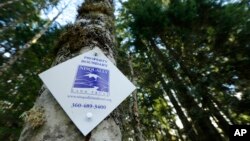Researchers at a British University have embarked on a decade-long experiment that will pump a forest full of carbon dioxide to measure how it copes with rising levels of the gas, a key driver of climate change.
The Free Air Carbon Dioxide Enrichment (FACE) experiment at the University of Birmingham’s Institute of Forest Research (BIFoR) will expose a fenced-off section of mature woodland in Norbury Park in Staffordshire, West Midlands, to levels of CO2 that experts predict will be prevalent in 2050.
Scientists aim to measure the forest’s capacity to capture carbon released by fossil fuel burning, and answer questions about their capacity to absorb carbon pollution long-term.
“[Forests] happily take a bit more CO2 because that’s their main nutrient. But we don’t know how much more and whether they can do that indefinitely,” BIFoR co-director Michael Tausz told Reuters.
Carbon dioxide record
The apparatus for the experiment consists of a series of masts built into six 30-meter-wide sections of woodland, reaching up about 25 meters into the forest canopy.
Concentrated CO2 is fed through pipes to the top of the masts where it is pumped into the foliage.
Last year the U.N World Meteorological Organization (WMO) announced that the global average of carbon dioxide, the main man-made greenhouse gas, reached 400 parts per million (ppm) in the atmosphere for the first time on record.
“The forest here sees nearly 40 percent more CO2 than it sees normally, because that’s what it will be globally in about 2050; a value of 550 parts per million, compared to 400 parts per million now,” Tausz said.
Deforestation
With deforestation shrinking the carbon storage capacity of the world’s forests, researchers hope that a greater understanding of their role in climate change mitigation could help policymakers make informed decisions.
“We could get a clear idea of whether they can keep helping us into the future by sucking up more CO2,” Tausz said.
The remainder of the Norbury Park woodland is open to the public and will not be affected by the experiment.










